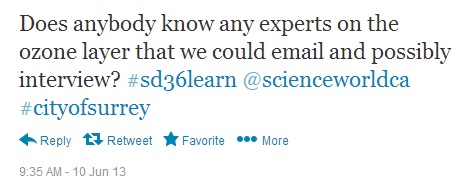On twitter this week we received the following question from Sunrise Ridge Elementary in Surrey:

When we receive questions like this we either a) respond ourselves if we have an expert staff member or b) extend the question to our broader volunteer science networks either through Scientists and Innovators in the Schools or the Community Scientist Initiative. In this case we reached out to a Community Scientist, Jordan, with Mme Bunker's class' question:
We were wondering how the thinning ozone layer is affecting the ocean levels?
Jordan responded directly to Mme Bunker's class with the following:
The short answer is that the thinning of the ozone layer has almost no affect on ocean levels. The long answer is that the thinning of the ozone layer has slightly reduced global sea levels, but the reasons are pretty complicated.
First, ocean levels aren't primarily affected by the thinning of the ozone layer. Sea level rise over the last century has mostly been caused by global warming from humans adding greenhouse gases like carbon dioxide to the atmosphere. Warming the Earth melts glaciers on land which adds water to the ocean, and also water expands when it heat up. These two effects have caused average sea level to rise about 19 centimetres since the year 1900.
Having said that, the thinning of the ozone layer does have a small effect on global warming, in two ways. First, the ozone layer stops ultraviolet radiation from the sun from reaching the Earth's surface. A thinner ozone layer means more ultraviolet radiation will reach the Earth's surface and will cause the Earth to warm. Second, ozone is a weak greenhouse gas, so it acts like a blanket and stops the Earth's heat from radiating to space. Thinning the ozone layer lets more heat escape from the Earth and causes cooling.
It turns out that the total effect of the thinning ozone is that it slightly cools the Earth. The ozone hole mostly occurs over Antarctica. During winter in Antarctica the sun doesn't shine, so there's no ultraviolet radiation to heat the Earth. On the other hand, during summer the sun never sets, but Antarctica is covered with ice which reflects a lot of the extra ultraviolet radiation back to space. Thus, ozone layer depletion doesn't cause much extra heating. The biggest effect is a reduction in the greenhouse effect, which cools the Earth.
So, the thinning of the ozone layer has cooled the Earth slightly, which has actually prevented a small amount of sea level rise. How much? Well, without the thinning the ozone layer sea level rise since 1900 would have been about 20 cm, instead of 19 cm, so it reduced sea level rise by about a centimetre.
Thanks, Jordan!